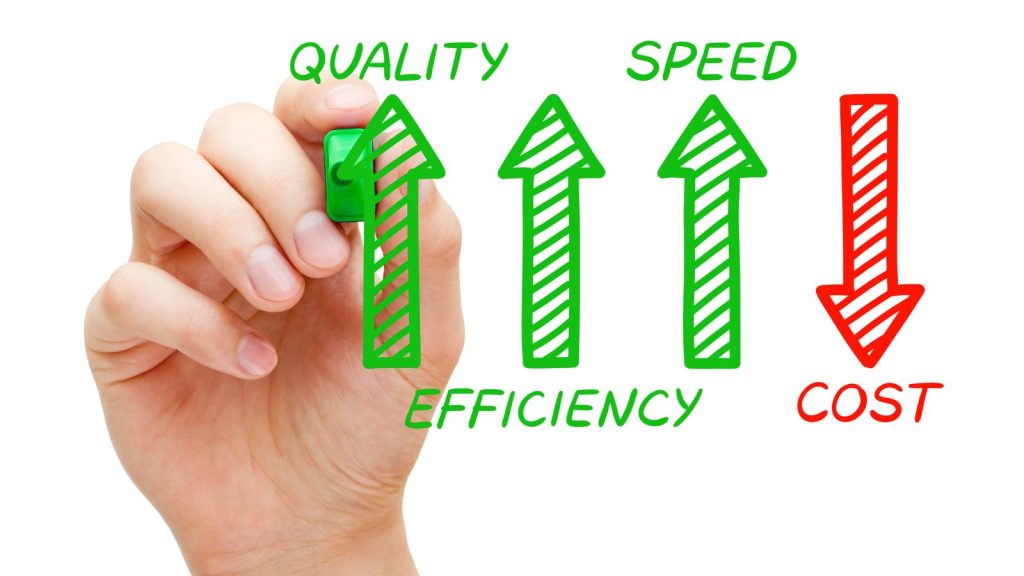Product information, such as attributes and digital assets like images, can’t be separated when creating quality custom content.
Visitors to your site are going to see the images before reading anything. Therefore, how you store and retrieve product information and digital assets will greatly affect your conversion rates. Failing to impress prospects immediately only makes it harder to convert them.
Rich images and quality product information make for engaging product pages.
In 2018, 56% of digital marketers reported using images or video in 100% of their content, because enriched pages naturally lead to increased sales. Thus, product information and images are central to the success of any eCommerce business. Ultimately, storing them together in a centralized database makes for easy retrieval by users.
Product Information Management (PIM) and Digital Asset Management (DAM) make retrieval easy.
Instead of spreading product information and images around, collect and store them in a central location. PIM and DAM create one source of content for your operation.
It isn’t enough to describe an item with words.
You need images, because customers need a concrete idea of what they want to buy. The question every shopper asks is, “What will this look like?” Providing rich images answers this question quickly and easily, converting lookers into buyers.
After all, the downside of eCommerce is customers can’t touch items.
eCommerce businesses have to make up for this by including rich images and videos. Hence, digital assets are crucial. If blurry, unattractive, incorrectly sized, or out of date, your assets will cause your customers to lose interest. Otherwise, they’ll end up buying things they don’t actually want.
PIM and DAM: the Perfect Combination
PIM is the processes and technology that manage information centrally. The focus is on the data required to market and sell items on one or more channels for distribution.
PIM uses automation to connect data sources and sales channels for the management and distribution of product information.
Simply, you can use PIM to manage your product catalog centrally. Therefore, regardless of the complexity and number of sales channels you sell across, your processes become efficient.
Store digital assets efficiently with DAM.
DAM provides a way to centralize, track, manage, and share digital content among internal teams and across sales channels. Each digital asset includes the metadata necessary to fully describe it. DAM implementation can save you thousands of dollars a year.
This completeness drives the positive online customer experiences that convert, maximizing your revenue.
To summarize:
- PIM is used to store product related information.
- DAM is used to store digital assets, like images, that aren’t necessarily related to just one item.
DAM can sometimes include functions to act like PIM.
But make no mistake, only in tandem can these systems best help increase operational efficiency by making information easier to find as a single source of truth.
As the digital world becomes more complex, eCommerce companies need to combine PIM and DAM to maintain competitive market edge.

Product Information vs. Product Image
The content attached to an item that defines its complexity is information.
Because a brand can only influence customers’ purchase decisions with correct information, selling different things requires different content. Obviously, managing product information can be a herculean task without the ability to organize centrally.
Product information serves as a guide through the buyers’ journey.
Chances are your customers already know what they want. But incomplete, low quality information can point them in the wrong direction, costing you sales. You need to publish superb and complete information to convert lookers into buyers.
Product photos communicate your information in a way text can’t by itself.
An image grabs attention much faster than text, especially when the image is large and colorful. Rich images also capture attention because shoppers will want to reconcile their expectations against the color, size, and style of your images. Success is matching the images on your pages with the picture in the customers’ heads.
Product images fulfill customers’ aesthetic needs.
Images help satisfy the need for understanding a product’s physical appeal, showcasing qualities in a way that builds emotional and psychological connections with your customers influencing them to buy from you.
It’s also critical to allow a zoom feature for your photos.
If customers can see a large amount of detail, there will be less chance they will miss something about your items. Zoom helps eliminate disappointment.
Complete product information boosts appeal, driving up traffic on your site.
This is critical, because maximizing the connection between your offerings and your brand in the minds of your customers, results in brand loyalty. Statistics have revealed that a large number of customers said the quality of an image is very important when selecting something to buy.
Long story short, complete data and rich images drive higher engagement and sales.

The Visual World
Today’s focus on the visual centralizes the role of images and videos in telling brand stories. Social media platforms, like Facebook and Instagram, have embraced image sharing and become central to marketing and sales. Brands that convey a consistent and well-managed message can be as much as 20% more valuable than those that don’t (source).
Digital assets require product information to make sense.
Clear information must be communicated so customers understand your message as perfectly as if they were in a brick and mortar store. Also, eCommerce brings with it the tremendous scale of product diversity, meaning you will have more information to manage.
eCommerce puts the customer in the driver’s seat and they increasingly demand more consistent information to make informed decisions. Customers don’t accept excuses from brands delivering anything short of their full expectations. The message is clear: fulfill your customers’ expectations or lose them.
The Importance of Storing Product Information and Images Together
Most customers research before making final purchase decisions.
Product information and images are incredibly important, so take care and pay attention to the importance, completeness, and accuracy of that data. However, exactly how do eCommerce business owners benefit from storing items and images together?
Save your customers’ time.
If you don’t store information and images aren’t together, retrievals can often result in dead ends. Manually entering complete product information with matching images for everything your business offers will cost you hours. And it won’t even guarantee sales.
Increase efficiency with automated processes.
With automation you can easily keep information up to date with current trends. Automation means your business processes run faster, and the amount of errors and time wasted fixing them are reduced. Finally, you can easily update old images and push new ones out across your internal teams and external sales channels centrally.
Storing product information and images together increases team collaboration.
Because product information and images are easily accessible, making content becomes less of a chore. Explaining the accompanying cost savings is obvious, as centralization reduces redundant work making employees more productive.
As a result of the superior data management PIM offers, organized information can be shared across all customer engagement platforms easily. Thus, this delivers accurate information at the right time with a minimum of wasted effort becomes simple.

Ensure Consistent Delivery of a Winning Customer Experience
According to eBay, “It is not enough to sell on all platforms; you need to develop creative new ways for customers to engage with your brand.” If visitors come to your site and can’t get all the information they want, they’ll likely lose interest. Frustrated customers move on to an offer that can give them what they’re looking for.
Storing data on separate systems can lead to a fragmented, inaccurate display of information.
These broken promises will negatively affect your brand image. On the other hand, storing information and images together will lead to a single source of product content truth, guaranteeing consistency of information.
Customers have access to the virtual world on the go and at virtually any time.
They connect digitally to multiple channels and see varieties of the item they’re thinking of buying. This is why brand consistency across channels and platforms is key: to always communicate an identical message.
When a company manages its information with PIM, customers have easy access to superior, accurate, rich information, which leads to seamless delivery of a brand experience which meets or surpasses customer expectations.
Most customers who return products purchased online report receiving something other than what they expected.
This dissatisfaction is the result of communicating incomplete, inconsistent, and incorrect information to customers. The central storage of information and images reduces this, driving customer satisfaction, further driving sales.
The more reliable and complete your information and images are, the more you can control your customers’ experience. Ultimately, customers get the items they expect, increasing the chances of a repeat purchase from you.

Increase Sales
eCommerce shoppers are awash in options, so more often than not the brand that stands out will be the one they choose. According to Nchannel, “thirty percent of US online adults cited that they would consider buying from an online retailer they had never previously purchased from, if the retailer offered detailed product information.”
Comprehensive product information gets you closer to closing a sale, driving profitability.
Without proper management of your product information and images, your operation will be less efficient. Good information and high-quality images communicate your brand style making it more recognizable. Improved visibility drives improved sales.
Increasing social media use means the high-resolution images that generate shares and views are key.
As you consistently deliver complete information, with rich visual imagery, you help give your customers a better shopping experience. In the same vein, departments and teams have access to complete information, enabling them to deliver quality customer service.
Ultimately, these increase conversion rates and increase your profitability. This is because delighted customers are loyal customers who will keep coming back to buy.
Improve Search Engine Optimization (SEO)
When you’re at the top of search engine results, you get more clicks.
Shoppers rarely explore more than a page or two of their search result lists. If you don’t consistently produce unique, engaging content, it’ll be hard for your site to rank high in search results.
Accurate product information and high-quality images improve visibility. Together, they communicate the style of your brand, rendering it more recognizable.
Furthermore, search engine optimization is critical. SEO ensures brands rank high in search results when customers search keywords related to your items.
This gives you the edge over your competitors. As a result, your search engine ranking will increase. Especially if your site contains useful information that meets the needs of your target markets. If more people can find your site across different platforms and locations, more of them will buy.
Quality data minimizes the duplication of content. This means your message will be free of outdated images and information. Additionally, your search ranking ingrains your brand image in your customers’ minds, while generating more traffic to your site. The more familiar people are with your brand, the better your potential.

Increase the Quality of Your Product Content
High-quality product content leads to increased conversion rates.
The popular adage “content is king,” coined by J.W. Click and Russell N. Baird could hardly be more applicable to today’s eCommerce world. Today, quality content is composed of accurate information and rich images indeed rules.
Media in the form of digital assets has become popular. It has created a more appealing picture that drives engagement. You can sustain customer interest by delivering quality visual content. Centralized storage of information and images makes this possible.
With PIM, you can easily make custom content to appeal to different customer segments, creating unique experiences.
Industry-specific content allows you to narrow in potential clients with hyper-focused tailored content. It should be obvious that it’s difficult to achieve personalization without proper data management. Think about the sheer number of pictures you are currently trying to manage, for example.
High-quality information, with complete descriptions and plenty of images, reduces shopping cart abandonment and returns.
This increases sales and improves customer loyalty. The production of quality content drives conversions, if only simply because the correct image will be tied to the appropriate description. These simple mistakes are often the biggest killers.
How likely is it you have lost customers because your product information was incomplete, inaccurate, or not compelling enough to attract their attention? Without PIM, it’s very likely this is the case.

Pull It Together To Win
The average customer decides to trust your offer or not at the first interaction.
How will you increase initial customer trust just enough to prompt a purchase? How will you drive repeat sales? It all boils down to quality content. Essentially, you must publish remarkable content across all the platforms.
But to fo that, it starts with a unified system. PIM delivers an easy way to tie centralized, accurate information to rich, compelling images. This marriage helps build trust in your brand at every touchpoint.
To summarize, a PIM is necessary to consolidating info and images for a more informative experience, informative value, and streamline brand consistency.
When it comes to content, you must include both images and text.
Unite Textual and Visual Parts
Nothing is worse than seeing poor quality photos of the item you want to buy, especially when the description is impressive.
Remember, one photo is worth a thousand online sales, as most customers complete a purchase only when they’ve seen rich images. Strong online content contains accurate information and colorful images, increasing a site’s page views. An eCommerce product page without any visuals loses potential customers.
And we all know they will head directly to your competitors’ websites.
Provide More Informative Value
Storing information and images together makes it easy to provide customers with multiple views of each item. By creating a complete mental picture, pages become informative enough to permit prospects to buy. After all, how can you deliver information corresponding to your product images without storing them together?
To fulfill the desire to remain competitive, companies must leverage workflow on PIM and DAM to urge repeat purchases.
Streamline Brand Consistency
With PIM, your product information is complete and easy to find, while DAM helps differentiate product experiences. Harmonious storage of your information, delivering a consistent shopping experience, is key. Ultimately, consistency has vital, beneficial consequences for your eCommerce operations. Hence, you must centralize information and images to communicate a uniform brand message.
Now that you know why product information and images need to be stored in one central location, click here to see what Catsy can do for you.

